 School of Pharmacy Associate Professor Pamela Smithburger demos the Anatomage Table for students in the Emerging Technology Lab in the Health Sciences Library on Wednesday, March 19, 2025. (Photography by Rayni Shiring)
School of Pharmacy Associate Professor Pamela Smithburger demos the Anatomage Table for students in the Emerging Technology Lab in the Health Sciences Library on Wednesday, March 19, 2025. (Photography by Rayni Shiring)
By Phoebe Ingraham Renda
Reading in a textbook that a wrong medication dose or a missed lab result can trigger cardiac arrest is one thing. It's another to actually see the harm firsthand and in real time.
That’s why the University of Pittsburgh’s School of Pharmacy prepares its students by integrating augmented and virtual reality (AR/VR) to create realistic, interdisciplinary hands-on learning that brings textbook knowledge and difficult patient cases to life and into practice.
“I absolutely love the expressions on students’ faces when they first see the actual organs and it’s not a picture in the book and they see it in motion,” says Pamela Smithburger, associate professor in the School of Pharmacy, as she explains how students see their studies in a situation that is as close as possible to a real-life situation while using an Anatomage Table, an advanced digitized anatomy system.
At Pitt Pharmacy, integration of augmented reality into the curriculum began in 2008 with a course called "Simulation-Based Learning and Online Learning to Enhance Problem Solving Skills in Acute Care Pharmacotherapy." Initially funded by an Advisory Council on Instructional Excellence grant in 2008—won by Dean and Dr. Gordon J. Vanscoy Professor of Pharmacy Amy Seybert when she was a professor of pharmacy and therapeutics—the course continues to innovate teaching today, and its active-learning methods have been integrated into additional pharmacy courses, such as pharmacotherapy of cardiovascular disease.
“I think virtual reality, augmented reality and simulation are just amazing ways for all of the Health Sciences students, especially pharmacy students, to understand the complex approach to patient care and the needs of an interprofessional team,” says Seybert. “One of the things that we do very well here at the School of Pharmacy is to keep up with the ways to actively engage our learners, and put them in a real-life context so that they can see a medication recommendation, they can visualize a drug interaction, they can react to it in real time and truly help be the medication expert that's a part of the interprofessional team caring for our patients.”
The flipped classroom style of these courses allows students to spend all of their class time engaged in hands-on, case-based 3D learning to practice providing recommendations to patients, represented by Laerdal patient simulators, as part of an interprofessional team. To prepare, they review weekly lectures online and take pretests before they arrive.
“AR and VR sessions definitely helped because we got to apply what we were learning in lecture,” says Katherine Foley, a third-year School of Pharmacy student. “When you're actually in the simulation, you have to think on your feet because it’s time sensitive—we have to come up with a plan right there.”
Course content is consistently updated, and continued integration of new simulation technologies keeps the educational innovation alive. For example, simulated electronic health records have been added to give students time to "work-up" their patients with their small-group teams before providing treatment recommendations. Additionally, the Anatomage Table in the Emerging Technology Lab and virtual reality technology, using the SimX VR platform, transport students into 3D learning and realistic clinical environments.
“We're one of the only schools that has truly built a comprehensive patient case that walks the student pharmacist through all aspects of medication decision making,” says Seybert. “We're here at Pitt where we say, ‘hail to possible.’ It is possible to make us the greatest health science educational group to really immerse all of our health science students in this interprofessional setting and advance the critical thinking, the problem solving skills, and again, to make all things possible when it comes to pharmaceutical sciences, pharmacy and health sciences education broadly.”
